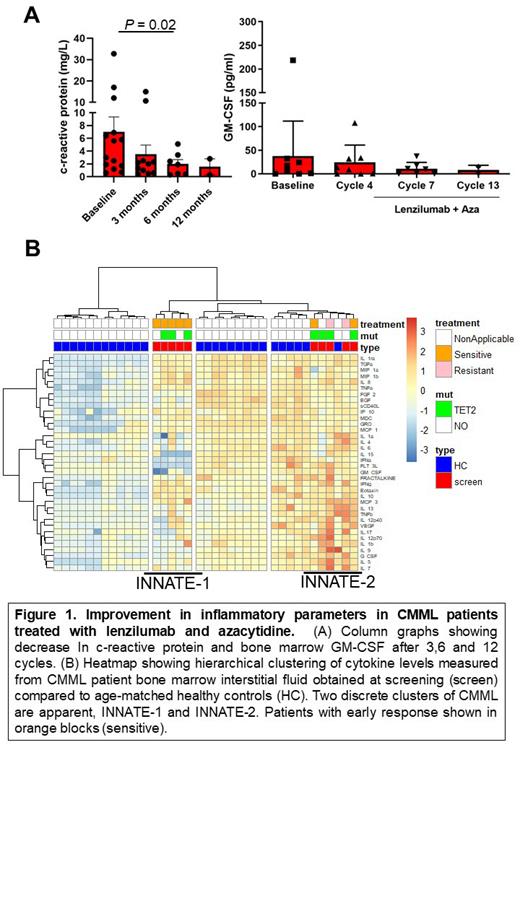Introduction: Chronic myelomonocytic leukemia (CMML) is characterized by accumulation of classical CD14+CD16- inflammatory monocytes driven in part by hypersensitivity to granulocyte-macrophage colony-stimulating factor (GM-CSF), a pro-inflammatory cytokine. Standard of care in CMML includes hypomethylating agents such as azacytidine (AZA), with complete response (CR) rates of 16-21% 1,2 and no reliable biomarkers that predict response. The complete pro-inflammatory profile of CMML is unknown and no treatment addresses the hematologic aberrations of CMML. Lenzilumab (LENZ; Humanigen, Inc., Short Hills, NJ) is a proprietary Humaneered ® first-in-class monoclonal antibody with best-in-class off-rate and affinity that neutralizes GM-CSF. The interim analysis of the PREcision Approach to CHronic Myelomonocytic Leukemia (PREACH-M; ACTRN12621000223831) trial showed LENZ/AZA treatment in 11 subjects with RAS-pathway ( NRAS/ KRAS/ CBL) mutations resulted in 8 subjects with complete response or optimal marrow response and improvements in hematological parameters. This report describes the cytokine profiles and systemic C-reactive protein levels of these subjects.
Methods: PREACH-M is a Phase 2/3 non-randomized, open-label trial in 72 subjects, aged at least 18 years, with newly diagnosed CMML based on the WHO 2016 criteria; and RAS-pathway mutations at a variant allele frequency ≥3%. Subjects received 24 cycles (every 28 days) of AZA (SC; 75 mg/m 2 for 7 days) and LENZ (IV; 552 mg; d1 & d15 of cycle 1 and d1 only for all subsequent cycles). Subjects without RAS-pathway mutations received the same AZA regimen and sodium ascorbate (IV; 30g for 7 days (15g for 1st dose only; 30g thereafter if no evidence of tumor lysis syndrome); PO; 1.1g on all other days). Cytokine profiling from bone marrow plasma was performed after 4,7,12 and 24 months using Milliplex Human Cytokine/Chemokine Magnetic bead panel and compared with 24 age-matched healthy subjects. Unsupervised hierarchical clustering with Ward's method sought distinct CMML patterns based on cytokine expression. C-reactive protein (CRP) was determined from blood samples using a routine assay. Variant allele frequencies were determined from bone marrow mononuclear cells using a 41-myeloid panel using Illumina Hi-Seq with a depth of 1000x.
Results: As of July 2023, 15 subjects were enrolled in the LENZ/AZA arm (8 females, 7 males with mean age 69; mean white cell count, 21x10 9/L; mean Hb, 121 g/L, mean platelet count; 74x10 9/L, mean blast count, 10.1%). CRP decreased from a median of 5.6 at baseline to 2.1 mg/L after 6 months of LENZ/AZA (P=0.02). GM-CSF and other pro-inflammatory cytokines were increased in CMML bone marrow plasma compared with healthy subjects. Hierarchical clustering of all subjects revealed 2 patterns of CMML, distinct from healthy subjects. Cluster “INNATE-1” was comprised of medium increases in inflammatory cytokines associated with innate immune response and M1 macrophage activation (IFN-g, IL-1b, TNFa, IL-12p70, IL-12p40, IL-17, Fractalkine, MCP-3). Cluster “INNATE-2” was associated with extreme increases of these cytokines. The mean pro-inflammatory innate immune score (sum of z-scores) was 20-fold greater in INNATE-2 compared with INNATE-1 ( P=0.055). Somatic mutations SRSF2, WT1, PHF6 were enriched in INNATE-2. All patients (5/5) in INNATE-1 showed 100% response (CR or optimal marrow response resulting in <5% blasts) to AZA/LENZ. Two subjects (2/6) in INNATE-2 demonstrated partial responses or haematological improvement thus far.
Conclusion: CMML is a disorder of profound innate immune activation, driven by GM-CSF and other pro-inflammatory cytokines. Early treatment with LENZ/AZA, a precision immunotherapeutic approach, leads to a) efficacy in INNATE-1 that exceeds historical CR rates for hypomethylating agents 1,2; and b) evolving efficacy in INNATE-2, in which pro-inflammatory activity is more robust.
1. Xu Y, Guo R, Miao M, Zhang G, Lan J, Jin J. Real-world data on efficacy and safety of azacitidine therapy in chronic myelomonocytic leukemia in China: results from a multicenter, retrospective study. Invest New Drugs 2022;40(5):1117-1124. DOI: 10.1007/s10637-022-01283-x.
2. Zheng X, Lv L, Li X, Jiang E. Efficacy and Safety of Hypomethylating Agents in Chronic Myelomonocytic Leukemia: A Single-Arm Meta-analysis. Glob Med Genet 2022;9(2):141-151. DOI: 10.1055/s-0042-1744157.
OffLabel Disclosure:
Ross:Keros: Consultancy; Imago BioSciences, Inc., a subsidiary of Merck & Co., Inc., Rahway, NJ, USA: Research Funding; Novartis: Honoraria, Membership on an entity's Board of Directors or advisory committees, Speakers Bureau; Takeda: Membership on an entity's Board of Directors or advisory committees; Menarini: Membership on an entity's Board of Directors or advisory committees; Celgene/BMS: Honoraria, Research Funding. Yong:Novartis: Honoraria, Membership on an entity's Board of Directors or advisory committees, Research Funding; Celgene: Research Funding; BMS: Honoraria, Research Funding. Fong:AbbVie, Astellas, RACE oncology, Jazz, Pfizer, Otsuka, Servier: Honoraria; AbbVie, Pfizer, Servier: Speakers Bureau. Yeung:Novartis: Honoraria, Membership on an entity's Board of Directors or advisory committees, Research Funding; BMS: Research Funding; Takeda: Honoraria, Membership on an entity's Board of Directors or advisory committees; Amgen: Honoraria, Membership on an entity's Board of Directors or advisory committees, Research Funding; Pfizer: Honoraria, Membership on an entity's Board of Directors or advisory committees. Hughes:Bristol Myers Squibb: Consultancy, Research Funding; Novartis: Consultancy, Honoraria, Membership on an entity's Board of Directors or advisory committees, Research Funding; Takeda: Consultancy, Honoraria, Membership on an entity's Board of Directors or advisory committees; Terns Pharma: Consultancy, Honoraria, Membership on an entity's Board of Directors or advisory committees, Research Funding; Enliven: Consultancy, Honoraria, Membership on an entity's Board of Directors or advisory committees.
Lenzilumab is a humanised IgG1 monoclonal antibody that neutalises granulocyte macrophage colony formation. This drug is being used for the treatment of CMML.


This feature is available to Subscribers Only
Sign In or Create an Account Close Modal